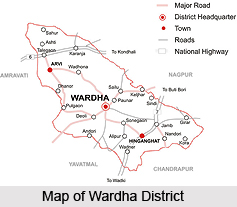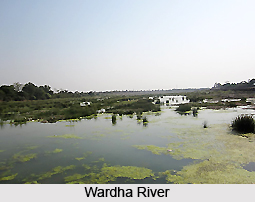 Wardha district is located along the western side of the Wardha-Vainganga valley in Maharashtra. The existing Wardha district was part of Nagpur district till 1862. It was separated for convenient administrative purposes, and Kawatha near Pulgaon was the district headquarters. In the year 1866, the district headquarters was shifted to Palakwadi village. Wardha District has three divisions and eight Talukas. The district is covered with the Satpura mountain range in the north whereas the western side is occupied by the valley of the Purna River. The plain plateau of the Nagpur district is on the eastern side, whereas the Wardha River flows from the boundaries of the north, west and south. The maximum temperature in the district reaches 46 degree Celsius whereas the minimum temperatures hit around 9.4 degree Celsius. The district is primarily agricultural, and among the major crops grown here are soyabean, cotton, jowar, wheat, pulses, groundnut, chana etc.
Wardha district is located along the western side of the Wardha-Vainganga valley in Maharashtra. The existing Wardha district was part of Nagpur district till 1862. It was separated for convenient administrative purposes, and Kawatha near Pulgaon was the district headquarters. In the year 1866, the district headquarters was shifted to Palakwadi village. Wardha District has three divisions and eight Talukas. The district is covered with the Satpura mountain range in the north whereas the western side is occupied by the valley of the Purna River. The plain plateau of the Nagpur district is on the eastern side, whereas the Wardha River flows from the boundaries of the north, west and south. The maximum temperature in the district reaches 46 degree Celsius whereas the minimum temperatures hit around 9.4 degree Celsius. The district is primarily agricultural, and among the major crops grown here are soyabean, cotton, jowar, wheat, pulses, groundnut, chana etc.
Location of Wardha District
Wardha district is located on the north-eastern side of the state of Maharashtra. The district formed part of the Nagpur district till 1962. Subsequently it was made into a separate district. Wardha district lies between 20 degrees 18 minutes north and 21 degrees 21 minutes north latitudes and 78 degrees 4 minutes east to 79 degrees 15 minutes east longitudes. It is bounded on the west and north by the Amravati district on the south by Yavatmal district, on the south east by the Chandrapur district and on the east by Nagpur district. The boundaries with the Amravati and Yavatmal districts are identified by the Wardha River. Wardha district is a part of the Nagpur Revenue division along with Bhandara district, Gadchiroli district, Chandrapur and Nagpur districts.
History of Wardha District
Though it has been difficult to trace, the earliest history of Wardha district can be traced back to the kingdom of Vidharba, when the mention of the river Wardha was made in the 2nd century. Wardha formed a part of the Chalukya dynasty from 550 to 750 A.D. Wardha was subsequently included in the territories of the Bahmani kings of Gulbarga near Solapur and Bidar. It passed under Mughal rule when it was taken over by Emperor Akbar in 1594. The district of Wardha was split into a separate district fom Nagpur district, of which it was a part, in 1862.
Demography of Wardha District
As per the 2001 Census, the population of Wardha district is 12, 36,736. The male population is 638990 whereas the female population is 597776. From the total population, 20.40 percent population is of the urban area and 73.60 are of the rural area. The population of the urban and rural areas are 3, 25,041 and 9, 11,695 respectively. The density of the population is 196 persons per square kilometre. The ratio of men to women is 935 women for 1000 men. The population of Schedule Caste and Schedule Tribes is 1, 58,630 and 1, 54,415 respectively. It is 12.83 percent and 12.49 percent for SC and ST respectively for the total population.
Administration of Wardha District
The Collectorate is headed by the District Collector / Magistrate who is in charge of Revenue Administration within the district and coordinates the functioning of all other state Government departments within the district. The Collector has different branches or departments which are headed by various officers of the rank of Deputy-Collector or Tahasildar. District Collector is supported by the Additional Collector who looks after a few branches of the office.
Education in Wardha District:
The literacy rates in the district are quite commendable. According to the last Census reports, there are a total of 8, 65,556 literates in the district. This accounts for 80.06 percent of the total population of the district. There are 739 upper primary, 310 primary, 168 secondary, 75 higher secondary schools and 9 Degree Colleges in district. Facilities for technical education are also available in the district. There are two Medical Colleges, two technical schools, eight Industrial Training Institutes (I.T.I.), and one Engineering College in the district.
Adult Education
In order to increase literacy and spread awareness about the same, Adult Education programs are regularly arranged by the District Adult Education Officer. In 1992-93, Wardha district was declared as a 100 percent literate district. Therefore to maintain the literacy of the newly literate peoples, the post literacy programs had been initiated from the year 1995-96. As such, there are 571 literacy centres working in the district in which around 32,208 adults have taken the admission.






